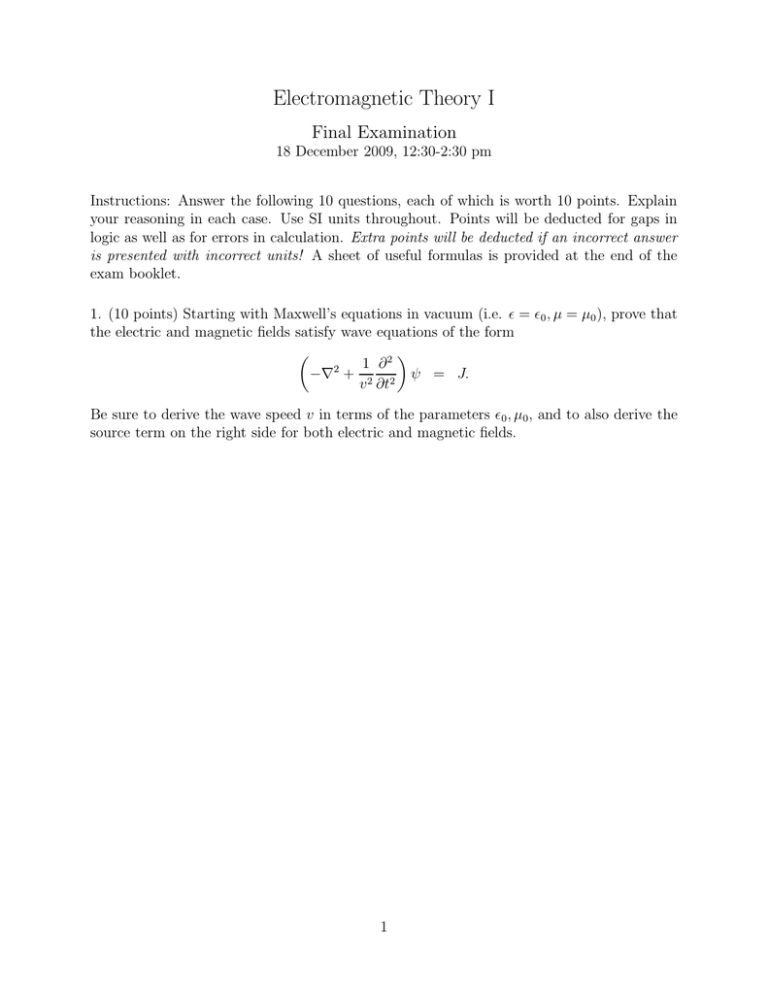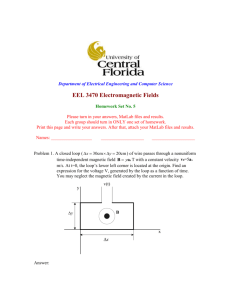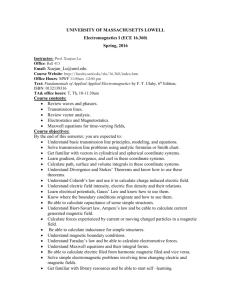Electromagnetic Theory I Final Examination
advertisement

Electromagnetic Theory I Final Examination 18 December 2009, 12:30-2:30 pm Instructions: Answer the following 10 questions, each of which is worth 10 points. Explain your reasoning in each case. Use SI units throughout. Points will be deducted for gaps in logic as well as for errors in calculation. Extra points will be deducted if an incorrect answer is presented with incorrect units! A sheet of useful formulas is provided at the end of the exam booklet. 1. (10 points) Starting with Maxwell’s equations in vacuum (i.e. = 0 , µ = µ0 ), prove that the electric and magnetic fields satisfy wave equations of the form 1 ∂2 2 −∇ + 2 2 ψ = J. v ∂t Be sure to derive the wave speed v in terms of the parameters 0 , µ0 , and to also derive the source term on the right side for both electric and magnetic fields. 1 2. (10 points) The electric dipole moment induced by a weak electric field always aligns with the field. In contrast, the magnetic dipole moment induced by a weak magnetic field can, depending on the substance, be aligned with the field (paramagnetic) or opposite to the field (diamagnetic). Explain this qualitative difference in electric and magnetic response in terms of the different ways in which the electric and magnetic fields contribute to the dynamics of a charged particle. (Hint: Consider the different field dependence of the electric dipole moment de and magnetic dipole moment dm of a particle: de = qr, dm = q r × (p − qA) 2m where B = ∇ × A, r is the particle’s position coordinate and p is its canonical momentum.) 2 (Questions 3,4,5) The half-space z < 0 is filled with a material with magnetic susceptibility µ = 0, while the half-space z > 0 has the vacuum susceptibility µ = µ0 . A long straight wire carrying current I is suspended a distance h above and parallel to the xy-plane z = 0. For definiteness let the wire lie in the xz-plane with current flowing in the positive x direction. 3. (10 points) State the boundary conditions at the interface satisfied by the magnetic field produced by this system. Note that B = µH → 0 in the bulk of the material. 4. (10 points) Derive the location, magnitude, and direction of the image current that would produce the same magnetic field in the z > 0 region as the material. 3 5. (10 points) Find the magnitude and direction of the force per unit length that the material exerts on the wire carrying the current I. Is it attracted to or repelled away from the material? (Questions 6,7,8) A plane electromagnetic wave of angular frequency ω is normally incident (i.e. the angle of incidence is 0) from pempty space on the plane interface of a material with µ = µ0 and index of refraction n = µ/0 µ0 > 1. For definiteness take the material to fill the half-space z > 0. 6. (10 points) With the notation E i , E r , E t for the incident, reflected and transmitted amplitudes, write down suitable forms for the space-time dependence of the electric field in the two regions z < 0 and z > 0, relating the wave number of each component to ω, n, c. 4 7. (10 points) In each of the two regions, determine the magnetic field corresponding to the electric field, as parameterized in question 5. Also write down the relations following from matching the electric and magnetic fields at the interface z = 0. 8. (10 points) Solve the matching relations and calculate the ratio of the time averaged energy flux of the transmitted wave to that of the incident wave. 5 (Questions 9,10) A neutral point electric quadrupole, with quadrupole moment Q11 = Q22 = −Q33 /2 = Q and Qij = 0 for i 6= j, is placed at the center of a spherical conducting shell with inner radius a and outer radius b > a. 9. (10 points) Derive the electric potential everywhere in space, expressed in spherical coordinates centered on the quadrupole. 10. (10 points) Derive the surface charge densities on the inner and outer boundaries of the shell, as a function of the angles θ, φ. 6 Formulae Maxwell’s Equations (SI units) ∇ · D = ρf ree ∂B ∇×E = − ∂t ∇·B=0 D = 0 E + P Multipole Moments Z k p = d3 rr k ρ(r) Q km = Z 3 ∂D ∂t ∇ × H = Jf ree + H= k m B −M µ0 1 m = 2 2 k d r(3r r − δkm r )ρ(r) Z d3 r[r × J(r)]k Laplacian in Cylindrical Coordinates ∇2 = 1 ∂2 ∂2 1 ∂ ∂ ρ + 2 2+ 2 ρ ∂ρ ∂ρ ρ ∂ϕ ∂z Laplacian in Spherical Coordinates 1 ∂ 2∂ 1 ∂ ∂ 1 ∂2 ∇ = 2 r + sin θ + r ∂r ∂r r 2 sin θ ∂θ ∂θ r 2 sin2 θ ∂ϕ2 2 Legendre polynomials and Spherical Harmonics 1 dl 2 Rodrigues : Pl (x) = l (x − 1)l Orthogonality : 2 l! dxl l+m (−)m 2 m/2 d Plm = (1 − x ) (x2 − 1)l l+m 2l l! dx s r 2l + 1 (l − m)! m P (cos θ)eimϕ Ylm (θ, ϕ) = 4π (l + m)! l Z 1 dxPl (x)Pl0 (x) = −1 Energy and Momentum Densities (Linear materials: D = E, B = µH) u = 1 (E · D + H · B) , 2 g =D×B Energy Flux and Stress Tensor (Linear materials: D = E, B = µH) S = E × H, T ij = E i D j + H i B j − δij u 7 2 δll0 2l + 1 Covariant Form of Maxwell Equations 0 −E1 E 1 0 Fµν = c(∂µ Aν − ∂ν Aµ ) = E2 −cB 3 E3 cB 2 1 µ 0 ∂ρ F µρ = J , ∂µ Fνρ + ∂ν Fρµ + ∂ρ Fµν c Lorentz Transformation of EM Fields E 0k = E k , −E2 −E3 cB 3 −cB 2 , J µ = (ρc, J ) 0 cB 1 −cB 1 0 dpµ q = 0, = Fµν pν dτ mc B 0k = B k v = γ(E ⊥ + v × B), = γ B⊥ − 2 × E c where p the primed frame moves with velocity v relative to the unprimed frame, and γ = 1/ 1 − v 2 /c2 . E 0⊥ B 0⊥ Coordinate Transformation under a Boost in the x-direction x0 = γ(x − vt), y 0 = y, z 0 = z, t0 = γ(t − vx/c2 ) Green Functions 1 ∂2 δ(t − t0 − |r − r 0 |/c) 2 −∇ + 2 2 G = δ(t − t0 )δ(r − r 0 ), Gr = c ∂t 4π|r − r 0 | 0 eik| − | 2 2 0 −∇ − k Gk = δ(r − r ), Gk = 4π|r − r0 | Spherical Bessel Functions (2l − 1)!! xl , nl (x) ∼ − (2l + 1)!! xl+1 eix 1 lπ (1) , hl ∼ (−i)l+1 x→∞: jl ∼ sin x − x 2 x cos x sin x (1,2) = jl ± inl , n0 (x) = − , hl j0 (x) = x x x→0: jl (x) ∼ (1) Vector Spherical Harmonics X lm 0 e ikz H0 1 ≡p LYlm , l(l + 1) Z dΩX ∗l0 m0 · X lm = δll0 δmm0 i 1 X lp i 4π(2l + 1) ∇ × jl (kr)i(0+ X l−1 − 0− X l1 ) + jl (kr)(0+ X l−1 + 0− X l1 ) = 2 lm k 1 X lp i = i 4π(2l + 1) jl (kr)i(0+ X l−1 − 0− X l1 ) − ∇ × (jl (kr)(0+ X l−1 + 0− X l1 ) 2Z0 lm k 8






